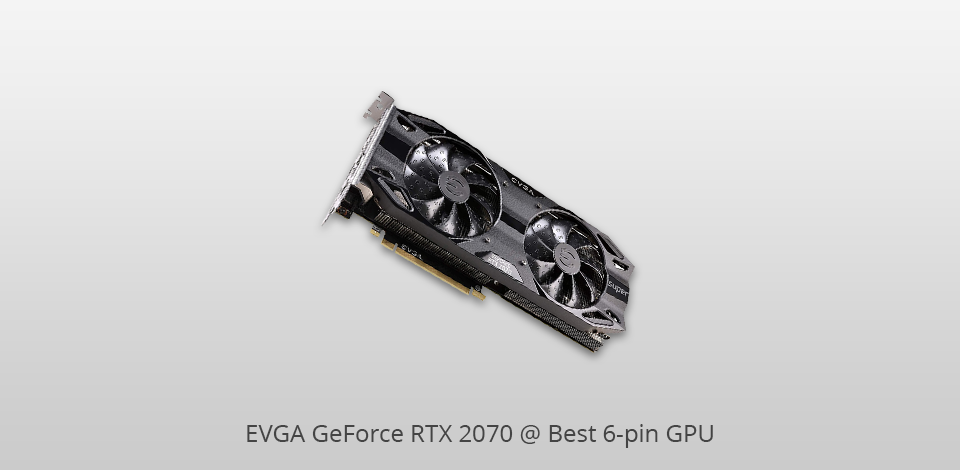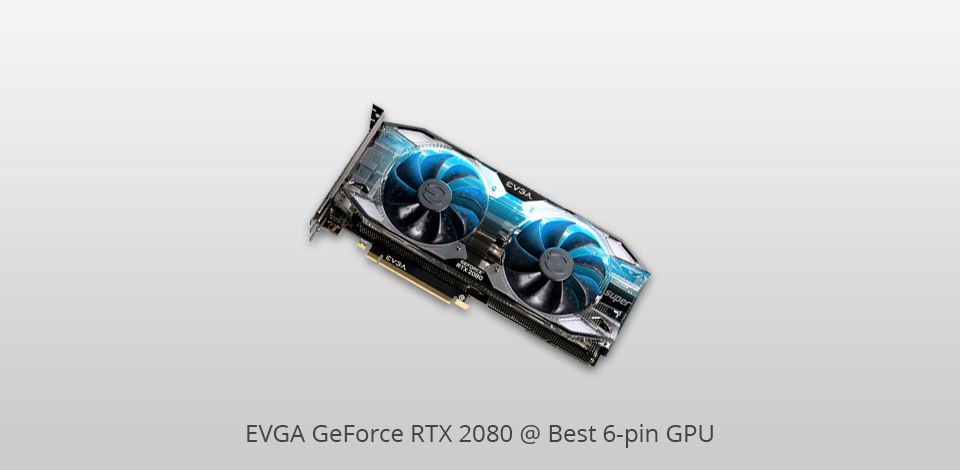The best 6-pin GPUs to buy this year.
One of the main components of any computer is a graphics card. It consumes a lot of power. Premium graphics cards require external power from a power supply to function well. Typically, external power comes through the 6-pin and 8-pin PCI-Express power connectors from the power supply. In this article, I considered and reviewed the best 6 pin GPU options.
Thanks to a 6-pin power connector, a graphics card gets 75 watts. If your graphics card requires more than 75W, a single 6-pin PCI-E power connector will suffice. The maximum power consumption of a 6 pin graphics card is 150W, with 75W supplied from the PCI Express x16 slot and 75W from a 6-pin connector. Standard cards from Nvidia and AMD come with a single 6-pin power connector, as a rule. Let’s take a closer look at different models.

Stream Processors: 2560 | Core Clock: 1770 MHz (boost) | Memory: 8GB GDDR6 | Memory Bandwidth: 448 GB/s | Power Connectors: 8-Pin + 6-Pin | Outputs: DisplayPort, HDMI, USB Type-C
The EVGA GeForce is the best graphics card with 6 pin connector since I have found no flaws in it. It does not overheat and operates without unnecessary noise. Just like other EVGA GPUs, the model is quiet and powerful. You won’t face any driver issues as well.
The only thing that might put you off is the lack of RGB lighting, but you can use the flashing lights option. The card requires two power connectors. I recommend considering this option if you are looking for a good GPU.

Stream Processors: 896 | Core Clock: 1710 MHz | Memory: 4GB GDDR5 | Memory Bandwidth: 128 GB/s | Power Connectors: N/A | Outputs: DisplayPort, HDMI
I was surprised by the good performance of this GPU, especially by its consumption-to-power ratio. It’s a good alternative to more expensive options as it costs around $150 and allows play games at 1080p, 60 FPS, at maximum settings.
This is by far the first Turing GPU that is close to becoming a bestseller nowadays as it allows you to play mid-resolution games.

Stream Processors: 3072 |Core Clock: 1845 MHz (boost) | Memory: 8GB GDDR6 | Memory Bandwidth: 496 GB/s | Power Connectors: 8-Pin, 6-Pin | Outputs: DisplayPort, HDMI, USB Type-C
The temperature of the EVGA GeForce RTX 2080 barely reaches 70°C. If you overclock if up to 2100GHz, it will reach 65-68°C. The clock speed never falls below 2050GHz. This 6 pin graphics card is quite energy-efficient and will improve your computer’s performance.
You will be pleased with the build quality. A triple-card slot perfectly supports the card. The EVGA offers a 3-year renewable warranty. You can also replace the graphics card.

Stream Processors: 2304 | Core Clock: 1580 MHz (boost) | Memory: 8GB GDDR5 | Memory Bandwidth: 256 GB/s | Power Connectors: 8-Pin, 6-Pin | Outputs: DisplayPort, HDMI, DVI-D DL
The XFX Radeon RX 590 is a good GPU based on Polaris architecture. The model operates well at 1080p and even better at 1440p. For users who haven’t upgraded their setups in the past couple of years, the XFX Radeon RX 590 would be a great option.
Plus, this model falls into the budget category and comes at $300. Since it comes with several AAA games, the XFX Radeon RX 590 is the best 6 pin GPU among analogs.

Stream Processors: 2560 | Core Clock: 1670 MHz (1925 MHz boost) | Memory: 8GB GDDR6 | Memory Bandwidth: 448 GB/s | Power Connectors: 8-pin, 6-pin | Outputs: DisplayPort, HDMI
The Sapphire Radeon RX 5700 XT is an improved version of AMD’s excellent Radeon RX 5700 XT, which only costs $10 more. You get the Dual-X thermal solution, which ensures low temperatures under high load and protects a graphics card from overheating.
Besides, the new Trixx utility makes overclocking easier. AMD is no longer planning to release GPUs with its own reference design and will instead sell other models, so the Sapphire Radeon RX 5700 XT is a great alternative to other options.
| IMAGE | NAME | FEATURES | |
|---|---|---|---|

|
EVGA GeForce RTX 2070
Our Choice
|
CHECK PRICE → | |

|
Gigabyte GeForce GTX 1650
Budget
|
CHECK PRICE → | |

|
EVGA GeForce RTX 2080
Premium
|
CHECK PRICE → |

Usually, the larger the size, the better, but when it comes to graphics cards, this is not always true. Unlike small graphics cards, large ones have better cooling systems and are less noisy. However, not every computer setup has enough space to fit a large graphics card. If you need a single card, and your PC case is big enough, then a large GPU won’t get you in trouble, but with a micro-ATX or mini-ITX, you need to choose your card size more carefully. Don’t forget that the larger the card, the greater its weight. With all aspects being equal, which is extremely rare, a heavy cooler performs better. This is because a heavier card puts additional strain on the PCIe slot, but it can sometimes cause a metal slot on your chassis to bend.
Video outputs are an important aspect to consider when choosing a video card, especially if you plan to use more than one monitor. Typically, almost every model has one DisplayPort and one HDMI slot, but additional connection types differ from manufacturer to manufacturer. If you have an older monitor model that requires a DVI-D connection, you should buy a graphics card that supports it. If you are looking for two DisplayPort or HDMI outputs, select a GPU that meets your requirements and pay attention to its version. Modern PSUs, even 500W, come with two 8-pin connectors, which are great for most GPUs. You may run into a problem if you want to upgrade your computer and the power supply only comes with 6-pin connectors. I do not recommend buying 6-pin adapters from Molex, as well as dual 6-pin and one 8-pin cable adapters.

If your card is factory-overclocked, most likely, it will come with a powerful cooling system. Some cards come with a liquid cooling system and an external radiator. Compared to conventional cooling solutions, this option is more effective. Weight is not a big deal since a radiator and a fan are mounted directly to your PC case. The main disadvantage of such systems is their high price, as they are at least $150 more expensive than other models. Besides, these designs take up a lot of space, which should also be taken into account. I believe that hybrid cooling solutions are only necessary for those who use premium graphics cards, like the RTX 2080 or 2080 Ti.
Cooling systems directly affect noise levels. Users love triple-fan coolers because, due to their size, they not only cool a GPU faster but also are less noisy than one or two louder fans. As a rule, blowers are the noisiest graphics cards. Despite this disadvantage, they are very useful for small ITX cases because they effectively dissipate heat.
If you’re looking for RGB lighting, then it’s better not to choose a basic graphics card. Best GPUs allow you to adjust brightness and colors. To customize lighting, you need to use software from the manufacturer. Due to the various lighting options available, I recommend buying a graphics card and a motherboard of the same brand. If you have purchased hardware components from different brands, you can use a utility to synchronize several types of RGB lighting.
If you have a smaller 6-pin PCI-e power supply and an 8-pin video card, you can physically connect the power supply to the video card.
Since graphics cards require an additional power supply, they cannot function without it.
A 6-pin ATX power supply connector is the motherboard power connector that is used to supply +12VDC to the processor voltage regulator. It is also used as an extra power source for premium graphics cards.
They are similar as there is no electrical difference between 8 and 6+2 PCI-E cables. The only difference is that you can detach some pins for compatibility with 6-pin PCI-E devices.